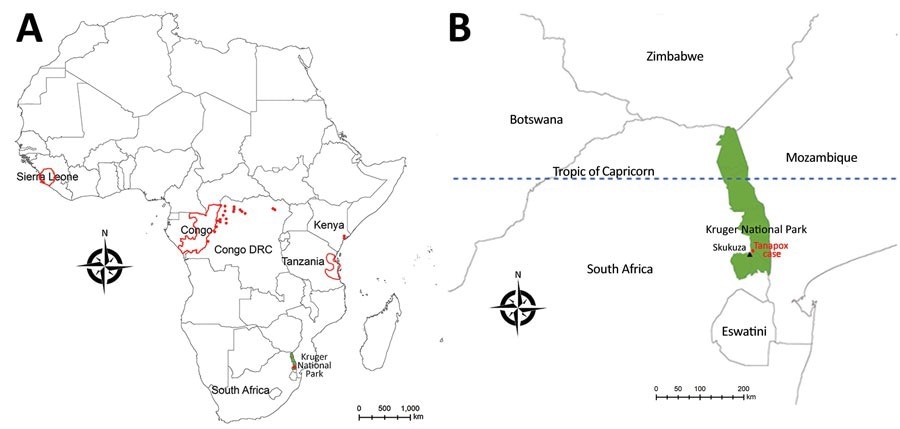A recent study published in the Emerging Infectious Diseases Journal describes a human case of tanapox in South Africa, a rarely diagnosed zoonotic disease.

Study: Tanapox, South Africa, 2022. Image Credit: nechaevkon/Shutterstock.com
Background
Tanapox is a zoonotic disease that is endemic to equatorial Africa. The last human case was reported almost two decades ago, with only four cases ever being exported via humans or nonhuman primates (NHPs).
A new case of this rare disease was diagnosed outside the equatorial belt, where all previous human cases had been identified. Expanded surveillance on this disease is necessary.
Introduction
The first human outbreak of tanapox was in 1957, followed by 1962, both in the Tana River valley, Kenya. Isolation of the pathogen showed it as a member of the poxvirus family, genus Yatapoxvirus, species Tanapox virus (TANV).
Research primates imported into the USA showed the presence of this virus, leading to its further detection in all 12 NHPs surveyed in a belt of territory encompassing Kenya, Ethiopia, Cameroon, Cote d'Ivoire, Liberia, and Senegal.
Suggesting that the natural reservoir of TANV was formed by NHPs, with incidental transmission to humans.
The ecological niche seemed to be from Somalia to Senegal, within the equatorial zone, with the southernmost tip of the territory lying above the Tropic of Capricorn.
Human infection occurs across all ages and sexes, with over one in seven people in Tana River Valley communities being seropositive for the virus in 1971. This had dropped to less than one in ten by 1976.
Humans rarely transmit TANV to one another, and the most common transmission route appears to be the bite of blood-sucking insects whose mouths are contaminated by the virus.
This hypothesis is supported by the timing of the outbreaks, during times of high temperatures, high rainfall, and flooding of the river valleys, when insect bites are most common.
In this aspect, seropositivity studies in the Tana River valley in 1971 showed that the distribution of TANV resembles that of the West Nile virus, with a similar incidence for both. Mosquitoes of the Culex family might transmit both, probably a Mansonia species.
Tanapox presents with a mild fever, lasting a few days, sometimes with muscle aches and itching. The patient develops headaches and is exhausted.
This stage is followed by the appearance of one or two raised umbilicated painful nodules on the skin. These lesions break open without forming pustules. The local lymph nodes may sometimes be enlarged.
The lesions form within the epithelial layers of the skin. The cells contain TANV, which looks exactly like every other Orthopoxvirus.
Other possibilities to be excluded include cutaneous anthrax, other poxviruses, sporotrichosis, spotted fever rickettsial infections, tropical ulcers, insect bites, and scabies.
The infection is self-resolving, and no deaths have been reported so far. In the current study, the researchers examined the latest case, which emerged in 2022.
What did the study show?
The infection occurred in a woman volunteer in Kruger National Park (KNP), South Africa, who was 61 years old. She was living in a tent on the Sand River banks, about 20 km from the town of Skukuza, in an area infested by numerous species and numbers of insects.

Geographic distribution of recorded human cases of tanapox. A) Locations of previous tanapox cases reported in the literature. Red dots indicate cases acquired locally; red outlines indicate regions of countries visited by travelers to Africa. B) Location of the case acquired in Kruger National Park, South Africa, 2022. Green shading shows the park’s location; black triangle indicates town of Skukuza.
She had been bitten by ticks and other insects while walking along the overgrown trails.
She became unwell after leaving the territory. Initially, she noticed itching at the base of the thumb of the right hand, with a pale blister forming on the site.
This was followed by another on the left hand. Both became nodular over time. She also developed malaise, fatigue, and severe headaches.
The lesions were painful and exquisitely tender, eventually ulcerating to become dry open lesions. All healed over six weeks, with mild discoloration.
Skukuza is infested by mosquitoes, over 90% comprising two genera of culicines, namely, Culex and Mansonia.
Heavy rainfall and hot temperatures existed during the woman's stay, favoring mosquito replication. Other possible diagnoses were ruled out.
The histopathology of a biopsy from one of the lesions revealed a possible poxvirus infection due to the typical findings of acidophilic inclusion bodies within the cytoplasm with cellular vacuoles and ballooning cells within the deeper epithelial layers. Further biopsies and swabs were taken for electron microscopy and molecular diagnosis.
These showed brick-shaped viral particles with surface tubules and an outer membrane layer. The genetic material was partly identical or closely similar to available TANV sequences, and tanapox was diagnosed.
The genome could not be sequenced or the virus isolated, however, probably because the amount of material was limited.
What are the conclusions?
On the basis of the overlap between human tanapox cases and the geographic ranges of selected nonhuman primates, an ecologic niche model predicted that tanapox could be found from Somalia to Senegal, with the most southerly range above the Tropic of Capricorn."
However, this model excluded many NHPs with larger distribution areas because human cases had been found within a restricted area within the equatorial belt.
The current study enlarges this range beyond the southern tip of previous models and thus the list of potential reservoirs.
The emergence of tanapox is probably a multifactorial occurrence caused by climate change, the shrinkage of wildlife habitats due to human activity, and unpredictable environmental shifts. Closer monitoring is indicated to detect and track such newly emerging zoonoses.